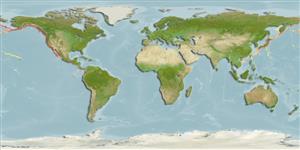Actinopterygii (ray-finned fishes) >
Scorpaeniformes (Scorpionfishes and flatheads) >
Liparidae (Snailfishes)
Etymology: Liparis: Greek, liparos = fat (Ref. 45335); fucensis: Named for Juan de Fuca Strait, its type locality (Ref. 6885). More on author: Gilbert.
Environment / Climate / Range
Ecology
Marine; bathydemersal; depth range 225 - 388 m (Ref. 2850). Temperate, preferred ?
Eastern Pacific: southeastern Bering Sea and Unimak Pass, eastern Aleutian Islands to Crescent City and San Simeon Point, central California, USA.
Size / Weight / Age
Maturity: Lm ? range ? - ? cm
Max length : 18.0 cm TL male/unsexed; (Ref. 2850)
Occurs near shore and to 388 m depth (Ref.2850). Feeds on shrimps and other crustaceans (Ref. 6885).
Life cycle and mating behavior
Maturity | Reproduction | Spawning | Eggs | Fecundity | Larvae
Chernova, N.V., 2008. Systematics and phylogeny of fish of the genus Liparis (Liparidae, Scorpaeniformes). J. Ichthyol. 48(10):831-852. (Ref. 79981)
IUCN Red List Status (Ref. 115185)
CITES (Ref. 94142)
Not Evaluated
Threat to humans
Harmless
Human uses
More information
Common namesSynonymsMetabolismPredatorsEcotoxicologyReproductionMaturitySpawningFecundityEggsEgg development
ReferencesAquacultureAquaculture profileStrainsGeneticsAllele frequenciesHeritabilityDiseasesProcessingMass conversion
Tools
Special reports
Download XML
Internet sources
Estimates of some properties based on models
Phylogenetic diversity index (Ref.
82805): PD
50 = 0.5000 [Uniqueness, from 0.5 = low to 2.0 = high].
Bayesian length-weight: a=0.01000 (0.00452 - 0.02213), b=3.06 (2.86 - 3.26), in cm Total Length, based on LWR estimates for this (Sub)family-body shape (Ref.
93245).
Trophic Level (Ref.
69278): 3.6 ±0.55 se; Based on food items.
Resilience (Ref.
69278): High, minimum population doubling time less than 15 months (Preliminary K or Fecundity.).
Vulnerability (Ref.
59153): Low vulnerability (24 of 100) .
